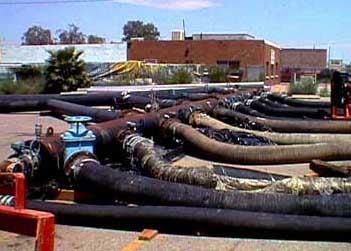Temporary Bypass Allows Big Cured-in-Place Sewer Rehab Job to Proceed
The pipeline's route under Grant Road, a major east-west artery through Tucson, Arizona, and the large volume of wastewater it transports daily added to the complexity of this undertaking, according to Jon Schladweller, deputy director of engineering for Pima County Wastewater Management, the authority which oversaw the rehabilitation project.
Serving some 36,000 residents of southern and southwestern Tucson, the trunk sewer transports 10 million to 12 million gallons per day (mgd) of sanitary wastewater. The decision to repair it came after video inspection work revealed extensive deterioration in a 2,500-foot long section of the 42-in.-diameter pipe.
Schladweller explained that during any rehabilitation project that was started, all customers had to be provided with continuous wastewater service, and that there could be no discharge of sewage on the surface. He added, "We also had the needs of the people who live and work near Grant Road to keep in mind. Tearing up one of the city's main streets for months and disrupting business and traffic was simply not an option."
When the go-ahead decision was made, the Pima County wastewater authority awarded a $1.8 million contract to Insituform Technologies, Inc. of Chesterfield, MO, to repair the line using the firm's proven non-disruptive system. This cured-in-place process restores the structural integrity of pipes and eliminates the common problem of infiltration that affects many wastewater collection systems, especially aging ones. To maintain service to its customers during the construction period, the County also required the contractor to install a suitable temporary bypass pumping system to handle the 12 mgd of sanitary wastewater normally transported by this reach of pipe.
How the Bypass System Was Prepared
The first challenge tackled by the contractor was the de-watering of the damaged section of the trunk sewer so the wastewater flow could be rerouted. Workers began by cutting into the interceptor and releasing the raw sewage into a temporary wet well. They had dug this just upstream from where the rehabilitation process was to be initiated.
Ten portable diesel-driven pumps were installed to pump the wastewater from the wet well into four 18-in.-diameter high-density polyethylene (HDPE) pipes. Secured against the concrete-lined bank of an existing drainage ditch, these pressurized temporary mains carried the wastewater downstream to a location approximately 3,000 ft away, where it was returned to the interceptor at a point beyond the repair.
The 10 pumps chosen for this bypass system had significantly more capacity than required by the normal average daily flow, or even anticipated peak flows, according to Mike York, technical representative for lnsituform on the project. "We needed a certain comfort zone in case any storm water got into the line. That's why we sized the pumps for peak wet weather flows," he explained. He also said that an appropriate number of pumps and safeguards were required to provide excess capacity if for some reason part of the system stopped operating at any time of the day or night.
Several weeks of preparation in the late summer of 1998 were required to assemble the bypass system and put it into operation. Despite the heavy rains that added to the normal daily flow rates it was called upon to handle, the temporary system operated without problems. Over the next four weeks technicians working around the clock on site monitored the system's operation, while the contractor's installation crew set about the task of rehabilitating the deteriorated line.

Seen here, a temporary arrangement of pipes and pumps arranged to bypass a section of a large wastewater interceptor sewer, the Insituform process allowed Arizona's Pima County Wastewater Management to rehab the system with no service interruptions.
Carrying Out the Re-lining Process
The rehab work was divided into two parts. A section of the trunk sewer about 900 ft in length was repaired with the first "inversion." The remaining 2,115 ft was taken care of with a second.
For each of the installation steps, a custom-made felt tube was impregnated with a liquid thermosetting resin. The workers then inserted it into the structurally deteriorated pipe by turning it inside out (inverting it) from an existing manhole. By elevating the point of entry and adding water, the tube was propelled into the pipe and inverted in the process by the head of water developed. One of the features of the system is that as the tube advances through the pipe, it conforms to the inside surface and negotiates bends and offsets with ease. After the tube was in place the water was heated and re-circulated to cure the resin and form a jointless and corrosion-resistant lining. The final step was to restore the service connections.
To cause the least possible disruption to traffic and other activities on the surface, the contractor chose to install the felt tubes during the early evening hours. Traffic became lighter at that time and the cooler evening temperatures were advantageous to the process. The curing phase continued throughout the night and the lateral connections were completed by morning.
By late September the Insituform team had completed the rehabilitation of this important trunk sewer and dismantled the temporary pipe and pump system. The project was reported to have met all of the Pima County Wastewater Management's objectives.
As a concluding comment, Jon Schladweiler said the County now uses the cured-in-place method on 80% to 85% of its wastewater collection system repair and rehab projects, including some that don't run under busy city streets. He sees the cured-in-place solution to the problems of dust, noise, traffic and pedestrian disruption, and the complexity caused by the presence of increased underground utility assets, as probably the best choice for pipeline rehabilitation.
Edited by Ian Lisk, Editor Emeritus, Water Online
